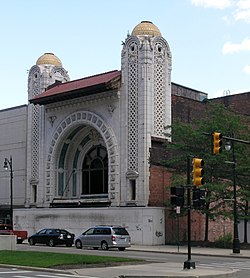Monroe Avenue Commercial Buildings
|
Monroe Avenue Commercial Buildings
|
|

The National Theatre (1911) at 118 Monroe Ave., the oldest surviving theatre in Detroit, a part of the city's original theatre district from the late 1800s.
|
|
| Location |
Detroit, Michigan |
|---|---|
| Coordinates | 42°19′58″N 83°2′45″W / 42.33278°N 83.04583°WCoordinates: 42°19′58″N 83°2′45″W / 42.33278°N 83.04583°W |
| Architect | Albert Kahn, Mortimer L. Smith, Sheldon Smith, Frank G. Baxter and Henry A. O'Dell |
| Architectural style | Late Victorian |
| NRHP Reference # | 75000968 |
| Significant dates | |
| Added to NRHP | February 13, 1975 |
| Designated MSHS | December 18, 1974 |
The Monroe Avenue Commercial Buildings, also known as the Monroe Block, is a historic district located along a block-and-a-half stretch at 16-118 Monroe Avenue in Detroit, Michigan, just off Woodward Avenue at the northern end of Campus Martius. The district was designated a Michigan State Historic Site in 1974 and listed on the National Register of Historic Places in 1975. The thirteen original buildings were built between 1852 and 1911 and ranged from two to five stories in height. The National Theatre, built in 1911, is the oldest surviving theatre in Detroit, a part of the city's original theatre district of the late 19th century, and the sole surviving structure from the original Monroe Avenue Commercial Buildings of the Antebellum period.
The early buildings on the block were constructed in Victorian commercial style, designed by architects such as Sheldon and Mortimer Smith during the mid-to-late 19th century. The Johnson block, in particular, constituted what was at the time one of the last remaining blocks of pre-Civil War buildings in Detroit. In the nearby Randolph Street Commercial Buildings Historic District, the building at 1244 Randolph St. is a rare survivor from the 1840s. The Victorian styled Odd Fellows Building (1874) is located at the corner of Randolph and Monroe.
The Monroe buildings were occupied by numerous short-term tenants through the years, including grocers, confectioners, and saloons. In the early 20th century, a wave of European immigration brought jewelry shops, pawn shops, and tailors to the area.
At around the same time, the Campus Martius area was developing into the entertainment center of Detroit. The Detroit Opera House, then located on the north side of the Campus across Monroe Avenue from the buildings in this district, anchored the area, and, in 1901, the Wonderland vaudeville theatre moved next door.
...
Wikipedia
